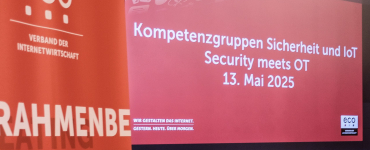In the run-up to the Smart City Expo World Congress in Barcelona, we interviewed Giovanni Coppa, Head of the eco Mobility Competence Group and Head of Data Center and Cloud Innovation at WOBCOM GmbH, about his expectations for the trade fair, and his take on current and future challenges in the field of Smart City and Smart Mobility. eco members receive a 25 per cent discount on trade fair tickets. In addition, we have a limited number of free tickets. More here.
What do you expect from your visit to the Smart City Expo World Congress Barcelona?
Giovanni Coppa: During our presence at the Smart City Expo, we aim to showcase our work from the past four years in Wolfsburg and the surrounding region. We will highlight our development initiatives, the successes we have achieved and our vision of a smart city that is connected to the region’s needs and progress. We will present our Open Digital Platform (OPD), focusing, in particular, on the smart transformation of mobility and the smart use of municipal infrastructure.
Together with the city administration and numerous partners such as Stadtwerke Wolfsburg, you and WOBCOM have already designed and implemented a large number of intelligent applications for the smart city. In your view, where do we stand in Germany in the smart city sector?
Giovanni Coppa: It is difficult to provide a definitive answer to this question because there is no one-size-fits-all response that encompasses the entire country system. Certainly, there are numerous initiatives at the national level, with efforts aimed at promoting innovation through various projects. Additionally, at the regional level, significant work has been undertaken, and different strategies have been explored.
I find this diversification very interesting because, generally, we observe various labs, yet these findings cannot always be adopted. An ambitious project could involve gathering all successful use cases where we have the possibility to scale them and make them accessible to all. But without creating artificial barriers, just letting the innovation flow, without waiting for the perfect solution, and rather adapting during the implementation process to learn from it.
If you compare Germany to other countries represented at these fairs, you might think – at first glance – that the country has fallen behind. In reality, on closer inspection, there are many successful projects, use cases and application scenarios that could be taken as examples, and it is these that deserve more space and admiration.
Global players in the context of innovative smart city concepts are represented at Smart City Expo World. In your view, what are the decisive trends and challenges that will shape the industry in the coming years?
Giovanni Coppa: It is to be hoped that all these issues will one day be incorporated into the political planning of cities and countries. Already today, we are quickly realising that some technologies are commonplace, and we cannot speak of innovation.
The most significant trend will undoubtedly be integrated mobility in urban and suburban areas. The combination of technology and innovative processes will bring about an important change. Another critical issue in big cities is waste management and disposal. The transition to a circular economy model and waste prevention is one of the main objectives of the European Union.
Without active citizen participation, achieving the goals of a smart city is challenging. Citizen participation – supported by digital technologies – can indeed foster community cohesion and help solve common problems. This is especially relevant for issues in rural areas, which are currently being addressed, although in a less organic manner. A few years ago, connectivity in mountainous areas was a significant concern, and it was also resolved with more accessible technologies and the involvement of residents.
The increasing number of connections and sensors in cities requires the processing of a large amount of data. The trend will involve analysing this data directly on the sensor systems (i.e. “on the edge”) using edge computing. Technologies such as artificial intelligence and analysis software will increasingly be implemented directly in the devices. This will result in quicker responses in various contexts, such as mobility. Thanks to edge computing, hazards can be reported in real time and risks for drivers can be mitigated. The benefits of edge computing also include reduced bandwidth consumption, enhanced reliability, and decreased system latency. We will undoubtedly learn to invest in information gathering in a targeted and intelligent way.
Smart cities are not inherently safe cities. We have invested significantly in this area and continue to do so. The increased use of networks and the presence of big data make the “vulnerable areas” susceptible to potential cyberattacks. A smart city is, by definition, an interconnected system of services, businesses and people, nodes in a network that grows exponentially and seamlessly. As more devices become connected and integrated, the possibility of one of them being hacked, and thus destabilising the entire system, is a threat that must be seriously considered, especially when cities base critical decisions based on this information. Awareness and the right tools are essential for comprehending the data.
Climate change is omnipresent, and sustainability is becoming more relevant for investors, companies, politicians and each and every one of us. How can technology, urban needs and Mission Zero goals be effectively linked in a city?
Giovanni Coppa: It’s much easier because we are all already doing it. The coordination of mobility and the targeted use of mobility will be able to solve various problems in cities. By focusing on reprocessing consumer goods, recycling materials and packaging, and remanufacturing and repairing components, it will be possible to extend the life cycle of products and reduce the amount of waste. The smart cities of the future must also be able to produce biogas from agricultural and industrial waste to generate clean energy and reduce emissions.
Cities with a more circular economy would then have highly interesting growth opportunities. A recent report by the European Parliament estimates that the circular economy in the EU area can increase GDP by 0.5 per cent over the next ten years and create new jobs.
WobCom is responsible for mobility solutions, for example in the area of smart parking, and in cooperation with Martin Kumstel from Uber, you head the eco Mobility Competence Group. The Tomorrow Mobility World Congress is also taking place as part of the Smart City World Expo. How do you imagine a desirable and sustainable mobility scenario for the city of the future?
Giovanni Coppa: The year 2035 represents a significant milestone. According to the timetables set by the European Commission, this date marks for many the end of mobility as we have known it until now: New technological perspectives and new lifestyles suggest a change of pace that will make smart mobility one of the keys to the future of our cities and our environmental policies. Our ability to innovate in complex ecosystems will accordingly be crucial. The aim is, therefore, to analyse the potential contribution that modern technologies and innovations can make to the development of future scenarios that are not only desirable but also feasible, and to identify the factors that may facilitate or hinder their realisation. Within the framework of Gaia-X projects, much is being done to lay the foundations for cooperation between various companies while preserving their sovereignty.
What does it take to implement this vision of future mobility?
Giovanni Coppa: The future of mobility is strongly influenced by the evolution of decisions related to the energy sector and the related renewal and improvement of infrastructure. In each context, the speed of the transition to more sustainable mobility depends to a large extent on different combinations of political and strategic choices, supported by the development of technologies and measures that best fit into the existing and established urban reality.
The conditions for sustainable mobility in 2035 are already visible today, where travel habits are gradually changing: Car ownership is no longer a status symbol; walking or cycling is no longer seen as a necessity due to the lack of alternatives, but also because of their health benefits. The choice of means of transport is determined by a growing awareness of the contribution to environmental impact. In my opinion, factors will provide the necessary impetus for change: cost and a change in social culture.
Thank you very much for the interview.




